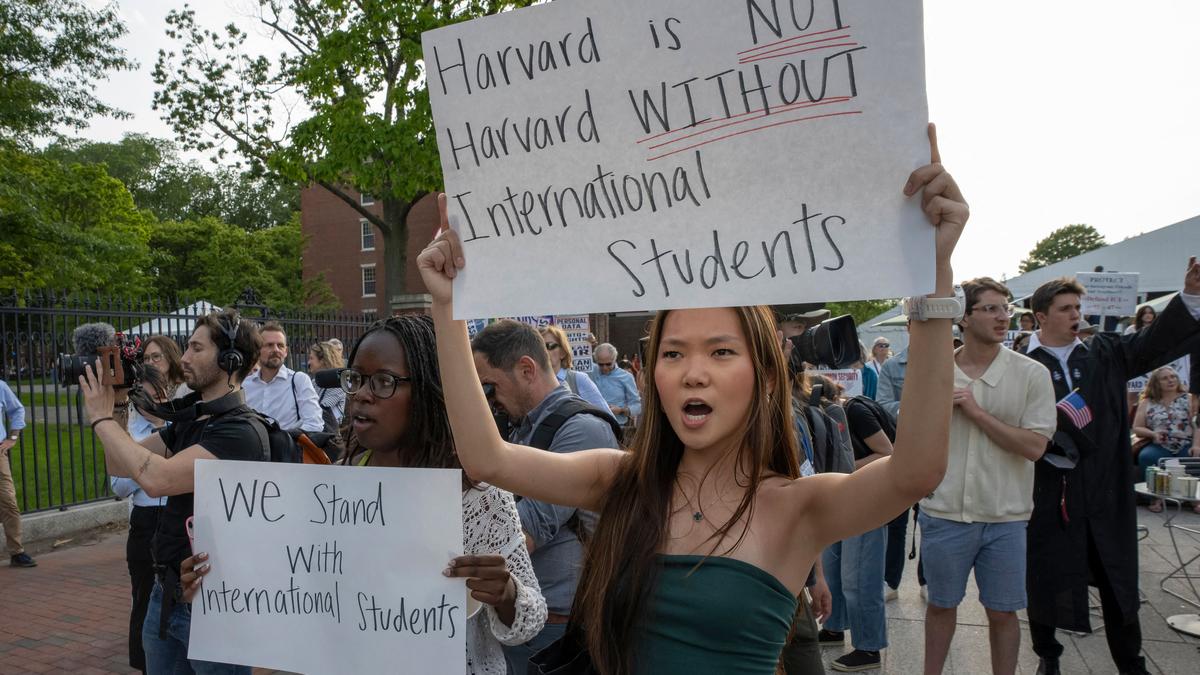This article forms a part of the Data Point newsletter curated by The Hindu’s Data team. To get the newsletter in your inbox, subscribe here
Welcome back, data enthusiasts!
As US President Donald Trump continues imposing restrictions on universities in the face of alleged anti-semitism, Indian students abroad and aspirants in the subcontinent have had to navigate uncertainty regarding their futures.
Over the course of these crackdowns since Trump ascended to his second term of presidency, we at The Hindu Data team used numbers to analyse the various ways in which students and the U.S. itself are impacted.
The first month of Trump’s second term saw a sharp decline in the number of student visas issued to Indians, notably steeper than the decline in visas issued to Chinese, Vietnamese, and Japanese students. We explored the visa denial rates of Indians over time as well as the average number of days Indian students have to wait for an approval when compared to students from other countries.
U.S. visas issued to Indian students decline by 30% in Trump’s first month of presidency
As federal investigations into U.S. universities continued and Harvard’s federal grants were frozen, we delved into what was touted as the cause behind these actions. Anti-semitic discrimination on campus was claimed to be the primary motivation, despite actions revealing a bigger interest in governmental regulation of private universities, as well as a disclosure of foreign funding sources and hiring and admission-related data.
We looked at how the U.S. fared in terms of academic freedom compared to a decade ago. We also looked into the incidents that warranted this federal surveillance on specific institutions, and how many of these were, in fact, protests.
Further, seeing that the federal government demanded that these universities immediately halt all DEI (Diversity, equity, and inclusion) programmes and policies, we looked at the racial and ethnic composition of students at these institutions, using data from the American Council on Education. We noticed that the universities classified as having high research activity tended to host more international students as well as more racially and ethnically diverse batches.
What is behind Trump’s crackdown on U.S. universities?
Beyond having revoked many students’ international visas, the Trump administration paused scheduling of new visa interviews globally and expanded its vetting of accounts of foreign students on social media. We looked into how much of enrolments into STEM degrees are foreign-born students, and how much economic value Indian students bring to the U.S.
As U.S. pauses new visa interviews, why international students matter | Data
What we published in the last two weeks
The International Monetary Fund (IMF) recently projected that India will edge past Japan to become the world’s fourth largest economy in 2025. We questioned the scope of absolute GDP as an indicator of development by compiling how India, Japan, and Poland, a country with a relatively low absolute GDP, fare in various other aspects such as education, industry, health, and more.
India’s rise to 4th largest economy: Does GDP growth alone show the whole picture?
In the weeks following Operation Sindoor, discussions on the efficacy of India’s home-grown defence capabilities roused curiosity in how much of our weaponry is imported. We collected data which shows that while India continues to import a large share of its defence equipment and weapons, domestic manufacturing has picked up exponentially.
Defence production in India receives a fillip | Data
We dived into the most exhilarating sports event of the week; the tennis Grand Slam final between Carlos Alcaraz and Jannik Sinner which amounted to one of the longest finals in the tournament. Using player stats and history, we examined what made this one of the greatest matches in men’s tennis.
Why the Alcaraz-Sinner French Open final is among the most epic battles
News in Numbers
Here are some important News in Numbers from last week:
Vehicles stuck in mud and silt following landslides in North Sikkim, Thursday, June 13, 2024.
| Photo Credit:
–
3.2 crores
Number of disaster displacements in India in the last decade
The report by the Geneva-based Internal Displacement Monitoring Centre (IDMC) said disasters triggered 264.8 million internal displacements or forced movements across 210 countries and territories during this period. East and South Asia were the most affected regions. In 2024 alone, 54 lakh displacements were recorded in India, the highest in 12 years. The report attributes rising displacement figures to both worsening climate events and better tracking.
Source: PTI
2.4 lakh
Number of Americans filing for jobless benefits last week (as of June 6)
Filings for U.S. unemployment benefits rose to their highest level in eight months last week but remain historically low despite growing uncertainty about how tariffs could impact the broader economy. New applications for jobless benefits rose by 8,000 to 247,000 for the week ending May 31, the Labour Department said Thursday. Weekly applications for jobless benefits are considered representative of U.S. layoffs and have mostly bounced around a historically healthy range between 200,000 and 250,000 since COVID-19 throttled the economy five years ago, wiping out millions of jobs.
Source: AFP
20%
Percentage increase in Pakistan’s defence budget this year
Pakistan announced on Tuesday a 20 percent hike in defence spending in this year’s federal budget, a month after a conflict with India that saw the worst violence in decades. Finance minister Muhammad Aurangzeb presented a $62 billion budget to parliament on Tuesday evening, allocating 14 percent to the military — rising from 2.12 trillion Pakistani rupees ($7.5 billion) to 2.55 trillion this coming fiscal year.
Source: AFP
Thank you for reading this week’s edition of the Data Point newsletter! Please send your feedback to [email protected]
Published – June 12, 2025 06:15 pm IST
